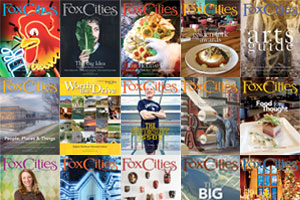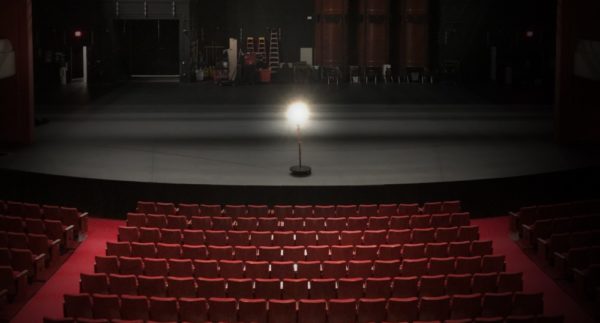God Save the Stage
Performing arts venues and organizations face upheaval during pandemic
Stages throughout the Fox Cities have gone dark. The COVID-19 pandemic has had swift and devastating effects on the performing arts which rely on people gathering, often shoulder-to-shoulder in enclosed spaces. This proves problematic during a pandemic when large groups and close proximity are either discouraged or outright prohibited.
Performing arts venues and organizations are now dealing with the fallout of canceled events, reduced seating capacities and an unknown future.
“We were all the first to close and will be the last to reopen,” says Dave Willems, owner and manager of Gibson Community Music Hall in Appleton whose doors have remained closed since its last show on March 12. “There is no revenue coming in. Zero. The challenge is how can we stay afloat through this to the other side, whenever that may be.”
Willems is also president of Willems Marketing and Events and producer of Mile of Music, Appleton’s original live music festival typically held in early August. The event, which was canceled in 2020, was estimated to have topped 100,000 visitors over four days with a spending impact to exceed $5 million.
“The biggest concern for events like Mile of Music and others is that we don’t know. The uncertainty is the challenge,” Willems says. “We just don’t know when we will actually be able to have shows again.”
“A Tapestry of Devastation”
For performing arts venues and organizations of all sizes, the financial impact of shutdowns and cancelations is substantial and all have been uniquely affected.
The Fox Cities Performing Arts Center announced in June that it would remain closed through the remainder of the year. With Broadway shut down until at least January 2021, Fox Cities P.A.C. President Maria Van Laanen says the nonprofit has had to drastically reduce operations. Currently, 16 percent of the Center’s staff is on payroll – 84 percent have been furloughed, 79 percent of whom are event-related staff such as bartenders and valet attendants.
“One hundred percent of our earned revenue sources are gone,” Van Laanen says. “Right now we are solely dependent on donations. We have had to relook at all spending and budget plans have been reexamined.”
The Fox Cities P.A.C. typically hosts 400 to 450 events per year ranging from Broadway shows to local high school performer showcases. Without the large nationally-touring shows which rely on a complex touring ecology to be profitable themselves, Van Laanen says the economics of a large presenting organization like the P.A.C. hosting only small events wasn’t financially feasible. Closing was the best way to reduce the center’s financial loss, Van Laanen says.
“Many elements added to this decision,” she says. “First the art we typically present isn’t available. Then what we could do is few and far between. We would need to bring people into a potentially risky situation, and the scales very clearly tip in one direction.”
The P.A.C.’s advantage is its $26.3 million Keystone Fund which was created to ensure the center’s sustainability through economic downturns. While a small portion of this fund can be used in times of need, such as the current COVID-19 pandemic, each dollar of the fund is strategically managed so that the Center can continue to successfully deliver on its mission for years to come.
“That position of strength will help us weather this storm, but it’s a storm nonetheless,” Van Laanen says. “The endowment fund is for situations like this, but we will have to rebuild it.”
For grassroots organizations like Attic Chamber Theatre (ACT), an Appleton-based community theater group which would have celebrated its 70th season in 2020, the cancellation of their three-show summer season is a tremendous loss to their bottom line.
“We lost our whole season. That’s $100,000 we didn’t make,” says ACT President Berray Billington. “Luckily most of our expenses had been minor. We hadn’t invested anything in costumes or lighting, but it’s still a loss that we weren’t able to generate this year.”
For its performances, ACT rents the theater at UWO Fox Cities which Billington says is a blessing during this time as organizations that own buildings and have maintenance costs are being hit harder financially.
Beyond the heartbreaking financials, the emotional loss felt by both artists and audiences is one of the hardest to reconcile.
“It’s one more piece in this tapestry of devastation,” Van Laanen says. “It’s so easy to take something like the arts for granted, but all of a sudden you don’t have that live arts experience and the things that are getting you through are the music playing in the background, the shows you’re binging and the books you’re reading. People are being reminded that the arts are absolutely vital to our mental, emotional and spiritual survival.”
Engaging Audiences & Artists Virtually
With all of its immense challenges, the COVID-19 pandemic has presented some interesting opportunities for innovation. Many performing arts venues and organizations have turned to digital options as a means to reach audiences.
The Fox Cities P.A.C. hosts a weekly livestream on Facebook and YouTube for behind-the-scenes chats with artists and industry professionals. The Grand Oshkosh debuted a YouTube channel, The Grand at Home, within a week of the shutdown to feature artist talks and performances. Appleton Downtown Inc. has been livestreaming its Heid Music Summer Concerts on Thursday nights in lieu of in-person gatherings at Houdini Plaza.
Jennifer Stephany, director of Appleton Downtown Inc., says the nonprofit organizes nearly 90 events a year, many of which are art-based performances or include a performance element.
“The arts are so critical to who we are as a community and how downtown has developed, so the impact of not having the performing arts is substantial. It feels heavy,” she says. “For a lot of people live music is a big part of their summer. They hunt these places out and to not have them is a real void.”
Arts instruction is another piece of the puzzle. Dayton Hendersen is the director of The Arthur Krempin School of Music & Art in Appleton, which is affiliated with First English Lutheran Church, but maintains independent funding and operations. Hendersen says the not-for-profit school, which is open to community and congregational members, has found opportunity online with virtual music lessons.
Children are nominated by their public school’s music teacher to participate in the year-round program. Students are provided with a piano, materials and lessons at no cost. Students are taught by Dr. Nathan Birkholz, who also serves as a staff pianist at Lawrence University and music director at First English Lutheran Church. Throughout the pandemic, students are continuing to receive instruction via Zoom.
“It’s been a successful way of continuing student progress during this time,” Hendersen says. “One of the messages I got from a parent was that their child’s lessons have been transformative not only for her, but their entire family. So while our efforts are not large in scale, they are making an impact.”
Van Laanen says the virtual realm provides a space to recreate connections previously found in person, but it’s not without drawbacks.
“Being the gathering place for the community and inspiring and igniting their imaginations is what we live for,” she says. “To toss these out in the virtual landscape, sometimes it’s hard to see those responses. When you’re in person it’s visceral and immediate and we are trying to find ways to get that same energy.”
Because of this, virtual delivery isn’t the answer for some organizations. Billington says ACT briefly considered virtual performance options but decided against it.
“You need personal interaction. If you do a play reading on Zoom, it’s just people reading on Zoom,” he says. “And to film a performance takes different direction, different lighting and action to do it on the screen versus in person. For us, that’s not what theater is about.”
The Show Must Go On
For some venues, reopening plans are in the works or even imminent. The Grand Oshkosh is scheduled for a soft reopening on September 12. President and CEO Joe Ferlo says among all the many challenges presented by COVID-19, establishing a reopening plan has topped the list.
“Up until then it was terrifying, but we were so in the moment. When we felt like we had our feet reasonably planted on the ground and looked at what it would take to reopen, it was daunting,” he says. “You look over the cliff and wonder what it’s going to take to get over it. Truly, you end up jumping and building your wings on the way down.”
The Grand has implemented extensive safety measures in advance of reopening. A minimum of six feet will be maintained between occupied seats which are grouped by two, three and four throughout the theater. Tickets must be purchased in advance. Instead of tearing tickets, ushers will mark them with a writing utensil to reduce contact. Digital playbills will replace print copies. Enhanced cleaning procedures are in place, including the use of an electrostatic sprayer. The list of precautions goes on and on.
The Grand normally has a capacity of 554. Today shows are being capped at 223. Ferlo says the metrics of creating programming for a theater at half capacity is challenging.
“It’s like shopping in a different aisle,” he says. “There’s two different things going on. One is money and the other is travel. I have to look more regionally at shows where with an audience of 200 people I can at least break even.”
Ferlo says this fall, shows were selected that feature smaller ensembles that can distance on stage and travel by car to ensure profitability and ticket prices remain low.
Similarly, for its next season, ACT is considering smaller cast shows with longer run dates and reduced audience sizes. Musicals may be off the table, Billington says, as they cost more to produce and pose greater health risks with singing and instrumentation. Billington fears this will turn off many audience members who favor these productions.
“The problem is we have to do a musical to beef up the box office,” he says. “If we can’t do those, will people come to the lesser known shows?”
So what does the long term future hold for live performances in the Fox Valley? While some believe the outlook is bleak, with out-of-work artists permanently turning to more stable jobs and venues shutting down for good, Willems is more optimistic.
“If we can make it through to the other side and have [Mile of Music] next summer, quite frankly I think we can rise up the ladder on the national music scene,” Willems says. “Appleton is strongly positioned in that regard. Music was a way to bring the community together and I think it’s a way to bring us back together after all of this if we do it right.”
While performances will certainly look different – think mask requirements, digital playbills and some form of symptom screening at the door – Van Laanen believes the future of the performing arts is certain.
“We will be back. We will be able to come together again on the stage,” she says. “It’s not a matter of ‘if,’ it’s ‘when.’”












Leave a Comment